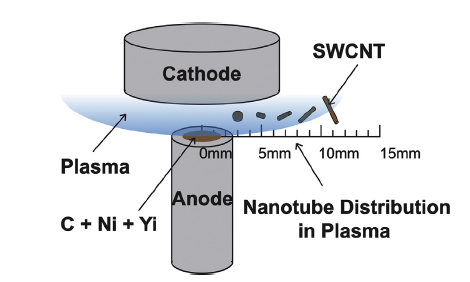<p style="text-align:justify"><font size="3"> MpNL uses the arc-discharge process to synthesize two-dimensional nanomaterials, nanotubes, and magnetic nanoparticles . See below for descriptions of several MpNL studies.</font> </p>

<p style="text-align:justify"><font size="3"> A recent MpNL study describes a novel highly controllable process of magnetic nanoparticle (MN) synthesis in arc discharge plasma. Both the size distribution and the purity of the MNs were made more controllable by adding an external magnetic field. The study showed that with the increase of the external magnetic field, the MNs get a better separation from the carbon impurities and the size distribution become narrower. In order to access biomedical potential of these MNs, the cytotoxicity has also been measured for the human breast adenocarcinoma cell line. It was concluded that MNs with concentration in cell of about 0.0001-100ug/ml are not toxic. </font> </p><!-- [et_pb_line_break_holder] --><!-- [et_pb_line_break_holder] -->

<p style="text-align:justify"><font size="3"> Arc discharge plasma is one of the most practical and efficient methods to synthesize various carbon nanostructures such as single-walled carbon nanotubes (SWCNT) and graphene with minimal defects and large yield. This is achieved due to the relatively high synthesis temperature and eco-friendly growth mechanism. Moreover, by introducing a magnetic field during synthesis process, large-scale graphene and high-purity SWCNT can be obtained in one step. In addition, the yield of graphene can be controlled by external parameters, such as the type and pressure of buffer gas, the temperature of substrate, and plasma density and temperature.</font> </p>

<p style="text-align:justify"><font size="3"> This MpNL experiment harvested two-layer graphene platelets with typical sizes in the order of several microns. The study presents state-of-the-art experimental data on various attempts to employ the arc plasma technique for graphene synthesis. We consider growth mechanisms including precipitation, surface-catalyzed processes and a substrate-independent approach. The study also discusses future research prospects, including the potential of arc synthesis for growth of other types of two-dimensional materials. </font> </p><!-- [et_pb_line_break_holder] --><!-- [et_pb_line_break_holder] -->
